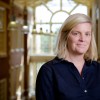This article is more than 5 years old.
Last week, I traveled to Las Vegas to attend the ACRL Rare Book and Manuscript Section (RBMS) pre-conference. The theme “Retrofit: Exploring Space, Place, and the Artifact in Special Collections” seemed to fit the location perfectly. The fact that it was the 55th RBMS (roman numeral LV) is perhaps the reason that this was the most attended RBMS pre-conference to date, or maybe people just wanted to go to Las Vegas. Either way, the conference was a great success in terms of attendance as well as powerhouse plenaries and jackpot panels.
Day 1 included a fascinating Plenary session titled “Book as Archive” featuring Brian Schottlander of The University of California, San Diego and Andrew Stauffer, an English professor from the University of Virginia. Schottlander discussed the broad reach of digitization projects, but also warned about the sometimes confusing and inconsistent results one gets when searching for digital content. He urged that metadata *is* the interface and searches across platforms including ArchivesGrid, OCLC, DPLA, and Google provided varied results. Andrew Stauffer’s presentation discussed “common” 19th century books in the circulating collections at University of Virginia. His discovery of marginalia emphasized the need for researchers to consider the historical book as a physical interface. The 19th century turned the corner on mass production and ownership of books, allowing many more people (including women) to own and interact with books at an intimate level. The problem today is that these books are too common and not considered “rare” based on their widespread availability in most libraries. With large scale digitization projects replacing physical with adigitized copy of a 19th century book, many of these books get weeded. Stauffer argues these books are more than printed test, they are also artifact and interface. Stauffer has put together what he calls a 1.0 version of a project that might help record unique and research worthy markings in otherwise common books called Booktraces.org. Heconsiders this a low barrier entrance into examining the non-rare books in our libraries. I found this plenary fascinating and the discussion that followed was lively.
Other highlights from Day 1 included a regional discussion and breakout session for people from the South. I joined the discussion group on regional identity and networking specifically to help inform me for my work as SNCA representative on SAAs Regional Archival Associations Consortium. We had a great discussion about networking and awareness of regional collections. I also ran into my past supervisor from the Library of Congress Prints and Photographs division, so it was a great chance to network and reconnect!
Day 2 was kicked off with an exciting Marketplace Plenary during which Michelle Light of UNLV flipped the monetary model for digitization. Light stressed that we as a profession spend too much time policing use of digital content rather than embracing the fact the “commercial” users tend to reach a larger audience. She touched upon the point that some of the profession’s practices of copyright permissions and monetary charges could be not quite legal. Although Light’s discussion of UNLV’s digitization business model may be a bit larger than we experience here at WFU, I intend to explore further UNLV’s new policies and procedures to see how we might be able to make some changes.
I presented on a panel along with Sara Logue of Emory University’s MARBL and Ronald Patkus of Vassar College. Our panel focused on “Space and Renovation” and got a very good turnout. As you can imagine, we are not alone when it comes to old buildings and space issues. The conversation was great after our presentations and the questions continued long after the allotted time. It was a valuableexperience and I would be happy to share my paper with anyone interested in reading it.
Other presentations that sparked my interest included Tom Hyry’s paper on the Susan Sontag born digital collection. Did you know Susan Sontag sent an email with the subject “Whasssuuup?” Elizabeth DeBold of Duke University presented on the Religion in North Carolina project, of which WFU is apartner. Yale University’s bookplate collection was the subject of Molly Dotson’s paper. She is using the bookplate collection to bridge the research of art students researching both design and historical aspects of design. I very much enjoyed this presentation and would love to think of more creative ways to integrate our collections into curriculum.
I found this conference a wonderfulexperience for idea sharing and networking. I would love to discuss further any of these points or other experiences I had on this trip. Thank to all who made my attendance possible, it was a great opportunity.

3 Comments on ‘Rebecca at RBMS LV’
RBMS was the place to be this year–lots of food for thought, based on my Twitter feed. And your presentation received a couple of tweets too!
Congratulations on a great conference, presentation and experience. I enjoyed reading about book traces.org.
Thanks for reporting.